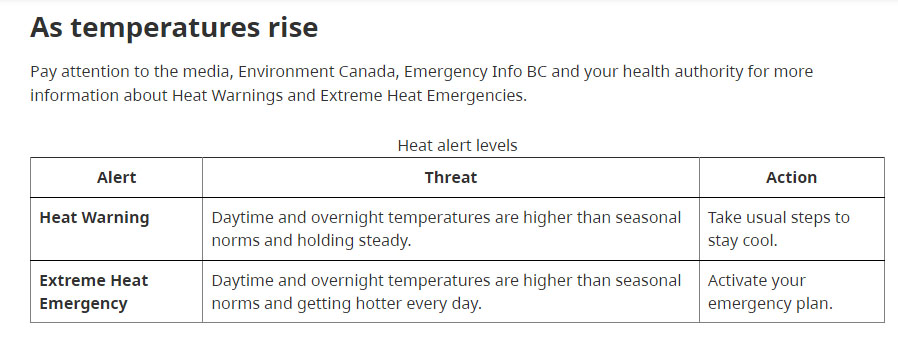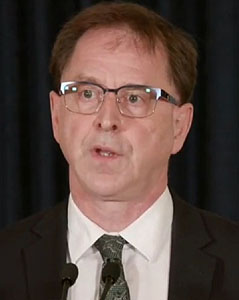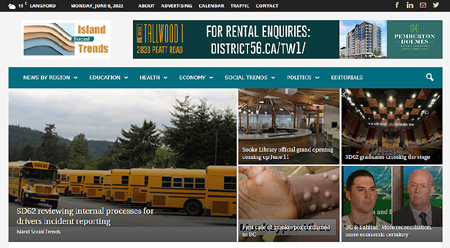Wednesday June 8, 2022 | VICTORIA, BC
by Mary P Brooke, B.Sc. | Island Social Trends
The Province is launching the BC Heat Alert and Response System (BC HARS) to help ensure people, First Nations communities and local governments have the tools they need to stay safe during heat events. Under BC HARS, the Province is prepared to issue a Broadcast Intrusive alert for extreme heat emergencies.
The Province is also bringing in additional measures to bolster B.C.’s ambulance system to better respond to a significant increase in 911 calls during a heat emergency.
The announcement about heat preparedness, including heat alerting was made by Mike Farnworth, Minister of Public Safety and Solicitor General, and Adrian Dix, Minister of Health, on Monday June 6. That was followed by the BC Coroners Service report and recommendations yesterday, further followed by Dix taking questions from media.
Building on previous announcement:
This builds on the recently announced extreme heat funding stream for First Nations and local governments under the $189-million Community Emergency Preparedness Fund for extreme heat-risk mapping, assessment and planning.
“Last summer’s unprecedented heat dome tragically resulted in hundreds of fatalities, making it clear we need to do more to be better prepared for future extreme heat events,” said Mike Farnworth, Minister of Public Safety and Solicitor General. “We’ve developed a new heat framework so we’re ready for the next heat event, and we are ready to issue Broadcast Intrusive alerts for extreme heat emergencies to ensure people are aware.”
BC HARS – warnings & emergencies:
BC HARS includes two categories of heat events: heat warnings and extreme heat emergencies. In the event of a heat warning or extreme heat emergency, the provincial government and local authorities will take appropriate actions based on their individual heat plans and processes.
For extreme heat emergencies, the Province is prepared to issue alerts through the national public alerting system, Alert Ready, which is already used to issue Amber alerts and tsunami, wildfire and flood warnings.
Learning from the heat dome:
It was starkly evident that the BC Government and many people in BC were caught unawares in June 2021 about the impending heat dome, despite detailed forecasts by Environment Canada. One health authority — Island Health — caught the wave, and the day before the full heat dome started did an extensive media session on June 25 for the benefit of islanders.
Yesterday the BC Coroners Service said the failure was not that of the health care system but more so about how communities and residents communicate among each other, and also that building structures in BC fall short on attention to cooling (as in BC the primary concern in the building code has been about keeping warm in cool and cold weather).
“It’s vital that we take the lessons we learned from last year’s devastating heat dome to make sure that the Province and our health-care system are as prepared and resilient as possible during extreme heat,” said Adrian Dix, Minister of Health.
“The new heat alert and response system and actions we’re taking to strengthen the ambulance system and emergency care will help ensure people across B.C. are safe during future heat waves,” said Dix on June 6.
BCEHS new clinical safety plan:
During an extreme heat event, BC Emergency Health Services’ (BCEHS) new Clinical Safety Plan will increase capacity, maintain quality patient service, protect staff health and safety, and ensure timely communication with various stakeholders.
The plan will guide BCEHS during an extreme event through actions such as reassigning staff to support areas experiencing increased call volumes, reducing turnaround times at key hospitals, and using alternate care pathways and transport options so ambulances remain available for life-threatening 911 calls.
This builds on actions the Province has already taken to strengthen the ambulance system and emergency care in B.C., including appointing a new chief ambulance officer and reconstituting the BCEHS board. In addition, BCEHS has added 125 new full-time paramedic positions in urban areas and 42 new dispatcher positions. BCEHS has also added 22 ambulances, nine of which are already in service, and converted staffing at 24 ambulance stations from on-call to 24 hours a day, seven days a week coverage.
To further ensure British Columbians are receiving appropriate pre-hospital care, BCEHS, in partnership with the Province and key stakeholders, is working to expand the care and treatment that paramedics and first responders can provide.
Extreme Heat Preparedness Guide:
The Province has also created a new Extreme Heat Preparedness Guide targeted at helping people prepare their residences for extreme heat and that provides advice about how to stay safe when temperatures rise. The guide is available in French, Punjabi, traditional Chinese and simplified Chinese and was created in partnership with the BC Centre for Disease Control.
Actions people can take to keep themselves and others safer during a heat event include identifying cool zones inside and outside their homes (community centres, libraries etc.), taking cool baths or showers, drinking plenty of water and checking in with vulnerable neighbours.
Heat illnesses include heat stroke, heat exhaustion, heat fainting, heat edema (swelling of hands, feet and ankles), heat rash and heat cramps (muscle cramps). Watch for symptoms of heat illness, including dizziness or fainting, nausea or vomiting, confusion, headache, rapid breathing and heartbeat, extreme thirst, and decreased urination with unusually dark yellow urine. If someone experiences any of these symptoms during extreme heat, they should immediately move to a cool place, start cooling down and drink liquids.
“Public alerting is a key tool in ensuring Canadians are aware of emerging threats in their communities.” said Bill Bair, president, Queen’s Privy Council for Canada and federal Minister of Emergency Preparedness. “Last summer, record-breaking temperatures in British Columbia resulted in loss of life, and this initiative by the Government of British Columbia will help warn residents of extreme heat waves, allowing them to take the necessary steps to protect themselves and each other.”
===== LINKS:
For more information about the BC Heat Alert and Response System: bccdc.ca/extremeheat (http://www.bccdc.ca/extremeheat)
PreparedBC’s Heat Preparedness Guide: www.preparedbc.ca/extremeheat
Environment and Climate Change Canada’s weather alerts: https://weather.gc.ca/warnings/index_e.html?prov=bc
For more information about emergency alerts in B.C.: https://www2.gov.bc.ca/gov/content/safety/emergency-management/preparedbc/evacuation-recovery/emergency-alerts
For more information about the Community Emergency Preparedness Fund, visit the Union of BC Municipalities’ website: https://www.ubcm.ca/funding-programs/local-government-program-services/community-emergency-preparedness-fund
===== BACKGROUNDER 1
BC Heat Alert and Response System
The criteria for the BC Heat Alert and Response System are as follows:
* Heat warning:
* Two or more consecutive days in which daytime maximum temperatures are expected to reach or exceed regional temperature thresholds and nighttime minimum temperatures are expected to be above regional temperature thresholds
* A moderate increase in public health risk
* Extreme heat emergency:
* Heat warning criteria have been met and daytime maximum temperatures are expected to substantively increase day over day for three or more consecutive days
* A very high increase in public health risk
Regional temperature thresholds are as follows:
* Southwest: daytime high of 29 C, nighttime low of 16 C
* Fraser: daytime high of 33 C, nighttime low of 17 C
* Southeast (Largely interior region of BC): daytime high of 35 C, nighttime low of 18 C
* Northeast: daytime high of 29 C, nighttime low of 14 C
* Northwest: daytime high of 28 C, nighttime low of 13 C
* See the ECCC website for a description of the geographical regions: https://www.canada.ca/en/environment-climate-change/services/types-weather-forecasts-use/public/criteria-alerts.html#heat
Heat warnings are expected one to three times per summer.
Extreme heat emergencies are expected once or twice a decade.
Consultation about further improving the system will continue with communities and stakeholders throughout 2022.
===== BACKGROUNDER 2
Government actions to strengthen B.C.’s ambulance system response to extreme events
BC Emergency Health Services has developed a new Clinical Safety Plan with four levels of escalation and predetermined actions to respond to system pressure and patient need including:
* Increasing capacity
* Redirect staff to improve dispatch and/or ambulance response times.
* Reduce turnaround times at key hospitals.
* Increase the use of alternate care pathways and transport options.
* Reducing demand
* Increase secondary triage to divert low-acuity calls from the 911 queue and save ambulance and paramedic resources for urgent calls.
* Delay or temporarily stop low-acuity interfacility transfers.
* In extreme cases, seek approval for no-send protocols on low-acuity categories of call.
* Reducing clinical/patient risk
* Mobilize non-frontline clinicians.
* Reassess unassigned events.
* Reprioritize events to ensure the most critical are responded to.
In addition, government took the following actions:
* Created 125 new full-time paramedic positions in urban areas (85 were operational in 2021 and 40 were operational in 2022)
* Created 42 new full-time dispatcher positions
* Added 22 new ambulances, nine of which are in service (two in Prince George and one in each of the following communities: Coquitlam, Burnaby, Surrey, Richmond, Langley, Abbotsford, Kamloops). The remaining 13 are expected to be in service by the end of 2022.
* Converted 24 ambulance stations from on-call paramedic staffing to 24/7 stations to enhance ambulance coverage for these communities
* Added more positions to 26 smaller stations where the scheduled on-call staffing model was introduced to provide more permanent, regular paramedic jobs
* Created further permanent regular positions across the province, improving ambulance service availability
* Is working to expand the care that paramedics and first responders can provide to patients on scene.
* Reconstituted the BCEHS board to focus solely on ambulance services
* Appointed a new chief ambulance officer responsible for the day-to-day management of the BC Ambulance Service and a newly created executive director of business operations and support
* Increased spending on BC Emergency Health Services from an average of $424,254,000 per year in 2017 to $559,141,000 per year today, a 31.8% increase.












